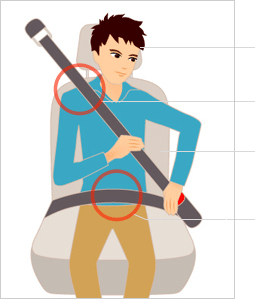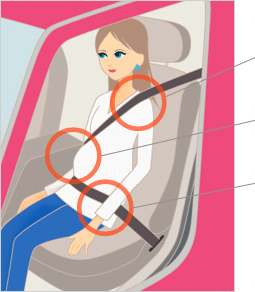
Do you know the right way to fasten your seat belt? If your seat belt is not properly fastened, it will not be effective. In fact, it can be dangerous not to have your seat belt fastened correctly. Whenever you are in the car, please always fasten your seat belt and make sure it is secured before the car starts to move.
- First, sit with your hips and back firmly positioned against the back of the seat. Also, have your seat in an upright position, as much as possible.
- Key Point!
- If you are not sitting firmly in your seat with your hips and back against the seat back, or if the seat is in an overly reclined position you may experience the “submarine effect”. This occurs when, during an accident, the body slips below the portion of the belt designed to restrain your hips and back. This may result in serious injuries.
- Grasp and pull the tongue portion and, after confirming the webbing is not twisted, insert it into the buckle portion until you hear or feel the “click.”
- Pull the portion of webbing from the buckle to your shoulder lightly away from your body, and then release it. This will eliminate any slack in the belt.
- Key Point!
- If there is slack in the seat belt between your body and the webbing, there is some potential you may move significantly in the event of a collision. Even though you had your seat belt fastened, your body may still impact other objects in the vehicle, possibly resulting in serious injuries.
- Please check to see whether you have adjusted your seat belt so that the portion designed to restrain your hips and back is low around your waist and is as tight as possible. Also, confirm the portion of the belt crossing over your shoulder passes between the base of your neck and the edge of your shoulder. If not, change the positioning of your seat or use the seat belt height adjuster to correct.
- The position of the headrest is also important. As a rule of thumb, adjust the height of the headrest so that your temples, which approximates center of gravity of your head, are positioned in the center of the headrest. (Note: In some vehicles, the position of the headrest may not be adjustable)
- Key Point!
- The term “headrest” should not be taken literally. In fact, the headrest is a “head restraint”. It is designed as a safety device to restrict the movement of the occupant’s head during a rear-end collision, lessening the force transmitted to the passenger’s head.
- Finally, it is best if the driver can operate the vehicle with no space between the shoulders and the seat. If the driver’s shoulders are not touching the seat, the occupant should either move the seat forward or adjust the seat back to a more upright position.

- Your temples should be positioned in the center of the headrest..
- This portion of thebelt should be centered on the collarbone.
- Avoid reclining the seat back too much.
- This portion should be low and close-fitting to your hips.
How pregnant women should fasten their seat belts

- The shoulder belt should be centered on the collarbone.
- The lap belt portion of the seat belt should be positioned to avoid any pressure being applied to the women´s stomach.
- Please fasten the seat belt in as low a position as possible.
SOURCE: takata
